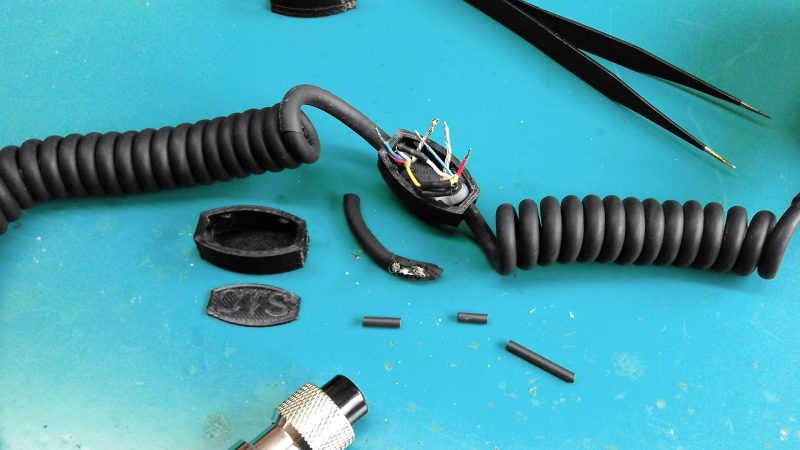We’ve all been there — a steamy night in the rainforest of Papua New Guinea, sweaty slumber disturbed by the unmistakable sounds of gnawing. In the morning we discover that a rodent of unusual tastes has chewed the microphone cable of our transceiver right half in two, leaving us out of touch with base camp. If we had a nickel for every time that’s happened.
It may sound improbable, but that’s the backstory behind [Marius Taciuc]’s 3D-printed mic cord repair. Even with more mundane failure modes, the retractile cords on microphones are notoriously difficult to fix. Pretty much any of the usual suspects, like heat-shrink tubing or electrical tape, are going to do very little to restore the mechanical stability lost once that tough outer jacket is breached. [Marius]’s solution was to print as small an enclosure as possible to mechanically support the splice. The fit is tight, but there was just enough room to solder the wires and stuff everything back in place. Cable ties provide strain relief where the cord exits the splice, and a liberal squirt of hot glue pots the joint. It’s not perfect — we’ll bet the splice acts as a catch point and gets a little annoying after a while — but if it gets you back on the air fast and cheap, it probably makes sense.
[Marius] entered this rat-race beating hack into the Repairs You Can Print contest. Do you have an epic repair that was made possible by a 3D printer? Let the world know about it and you might just win a prize.















‘Right half in two’
“Right half in two” … Pretty sure this is deliberate; I took it as a possible reference to the way YouTuber AvE talks, and Google suggests it’s not an unheard of phrase.
I read that as an “AVE-ism”
I would be satisfied with less content about 3D printing and con badges.
Indeed, lol…
Cheer up, dudes.
I feel strangely compelled to point out to you that it should have been “God’s”….
Don’t fret. I edited it.
There’s a type of heat shrink tubing, commonly used for underground joints, that allows for a lot quicker repair and just as rugged. It’s much thicker than normal heatshrink, a lot stronger, and has a hot glue coating on the inside so as you heat it to shrink it, it also glues it to the sheath at either end of the joint.
There you go:
http://www.ebay.com/bhp/marine-heat-shrink-tubing
Found as “Marine Heatshrink” or “Adhesive heatshrink”.
Cost a few bucks more, are thicker and glue really well.
And this stuff (+ a lighter to shrink it) is much more portable (into the jungle) than a 3D printer and kg’s of Filament. Without a printer a piece of plastic tubing, be it from an old ball pen, filled with hot glue would also have done it. Although not as good looking.
Yeah we use super glue and general purpose heat shrink for ocean floor some cold moulds but these failed a lot as prep work and finding Knicks and tears or stretching impeded work flow at least the 200kg injection moulder did the trick though when done correctly.
This articles is just some lazy cable joining above seriously 3d printing a tiny space considering the how many cores are in that cable and having repaired handset cables my self many times before because on a absurdly hot day people get stressed and rip out radios or handsets get caught / no cradle due to work wear and being in a remote loc replacement parts and waiting on a 3d printer is not practical at all.
Worst splicing I’ve seen yet what a waste of space, Offset the wires when soldering run some Teflon line with glue for tensional strength heat shrink sizing matters you can mate the connection again with minimal loss to that.
Also when dealing with a cord you know will be tugged on. J-hook your wires. A half decent J-hook with solder applied will hold up better than the surrounding wire. With shrink tube applied to each individual wire and then a larger section over top of it. A J-hook connection in-line will barely be larger than the unmodified sections while providing much better mechanical strength.
I’d use sugru. Much easier to for in the backpack than a 3D printer…
In a “backpack” situation, probably some “Gaffa”tape would have to suffice for the repair, perhaps with some reinforcement by a stick of wood or a piece of wire or just more gaffatape. :-)
Soy based wire coating?
What about the ROUTs?
Rodents of unusual size? I don’t think they exist.
There is a 1Kg rodent that runs around my apartment sometimes, and she has chewed on a couple of my cables. I keep telling the rodent not to do that.
Too much 3D printing stuff.
I developed this: https://www.amazon.com/Cord-Fix-Liquid-Repair-Frayed-Charging/dp/B01BNQVAC6
I would replace just about any coiled-spring-tangles-on-contact-heavier-than-wire-yanks-it-out-of-hand cord out there, with tough straight cord. These days vacuum hoses are junk with the same spring attached to the thing in your hand and 3 times the weight. Headphones with a spring attached (the cord) tugging at them while wearing them. Everyone using CPAP gets to use a hose not a heavy springy thing twisting the mask. Don’t make this mistake in trying the hose-air cooling on a 3D printer.
i have a cat that does this. im running out of heat shrink. she especially loves micro usb cables, and thats why i only own one.
Different strokes for different folks, but what’s wrong with the repair methods employed long before 3D printing was a thing/ This would take way too long if death was immediate. Would be a good practice to develop a habit of hanging the cords out of the reach of rodents.